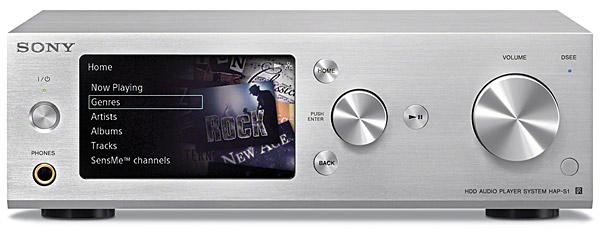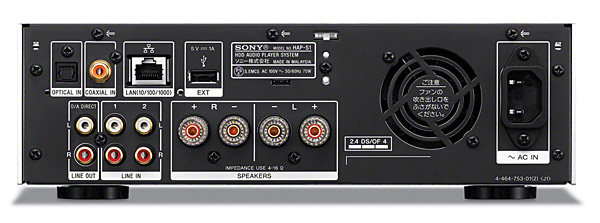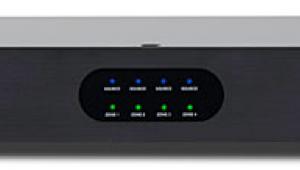I owned a demo unit of the vsx -53 and I loved it great sound, it blew and I now have a 2012 sc-65 Pioneer elite though I love it and it sounds great but its missing something from the vsx-53 I dont know why and the sc65 sounds great but I still wish i had the vsx-53 so good for you still using one
Sony HAP-S1 High-Resolution Audio Player

AT A GLANCE
Plus
500-GB hard drive
DSD capable
Serious fun to use
Minus
No live streaming from network devices
Lightweight amp
THE VERDICT
This handsome DSD-capable audio player with built-in storage takes the pesky computer out of computer audio—and it’s way more fun to use.
Sony made waves when they announced their intention to market three high-resolution audio (HRA) products built around the company’s DSD file format. True, there was a nascent HRA movement before Sony made the move, with loads of network audio players and USB DACs flooding the market. But somehow the Sony announcement provided the extra momentum that finally made HRA seem not just promising but inevitable. That the Consumer Electronics Association has also launched an HRA initiative is icing on the cake.
Sony and CEA have good reason for wanting to lead this parade: HRA is a bridge not only to better sound but also to a fresh generation of music lovers and audio buffs. Listeners are using file formats more and packaged media less. In many respects, Apple has become the new Sony. Now Sony wants to become the new Apple.
Sony unveiled three products: the HAP-Z1ES ($1,999), HAP-S1 ($999), and UDA-1 ($799). The top two models are hard-drive-based players with capacities of a full terabyte and half a terabyte, respectively; the HAP-S1, reviewed here, adds a small stereo amplifier intended to power desktop speakers. The bottom model is a USB DAC with no internal amplification or storage. All support the usual audio file formats plus Sony’s own DSD and ATRAC.
Love and Comfort
At first glance, the HAP-S1 isn’t just pretty. It’s comforting: You see just four buttons, two knobs, and a headphone jack. The most prominent front-panel element is a color display measuring 3.75 x 2.25 inches.
Navigating menus is easy using the smaller of the front panel’s two knobs along with the Back and Home buttons. The other knob is for volume, of course, and the other buttons are devoted to play/pause and power. A small bar-shaped remote has only play/pause, forward, back, power, volume, and muting keys.

Sony’s decision not to duplicate full front-panel functionality (including menu navigation and system settings) on the remote mystified me, but they say they expect users to opt for the colorful HDD Audio Remote app for iOS and Android devices, which does meet all of your music-browsing needs. Again, it omits system settings, offering only those for the app itself. But it does have an unusual Full Browser mode that simultaneously displays four columns of metadata: genres, artists, albums, and tracks. Swipe up or down to access music as rapidly as human dexterity will allow.
With a Class AB amplifier rated at 40 watts per channel, this product lets you connect speakers and go, though the spec sheet reads: “40 W + 40 W (4 ohms, 1 kHz, THD 10%).” A more common 8-ohm load would mean fewer watts, as would a lower distortion figure. See our Test Bench measurements. In practical terms, this amp fares best with high- efficiency speakers.
The HAP-S1 is a player-amp with storage, not a network player as I define the phrase, so a lot of features that you’d expect to find in a network player (or A/V receiver) are absent. This product is designed to transfer audio files from your computer and play them from its own hard drive; it also supports vTuner Internet radio. But despite the HAP-S1’s Wi-Fi capability, it won’t stream music directly from your PC or external drive in real time. It has a USB port but doesn’t function like a typical standalone USB DAC (unlike the Sony UDA-1). If you want to access music in real time from a computer, tablet, or phone, the device must be connected to the unit’s analog inputs. The USB jack isn’t iOS capable. AirPlay and Bluetooth are absent.
With storage at the heart of this product, how it transfers music to its internal hard drive is critical. The news here is mostly good. In addition to the above-mentioned HDD Audio Remote app for tablets and phones, Sony offers a HAP Music Transfer app for PC and Mac (esupport.sony.com/swu/8812). Set it up and let it run overnight, and in the morning, the contents of your computer’s music folder will be ready to rock on the player.
However, the Transfer app isn’t the only option. Once I set up the Wi-Fi connection between the Sony and my Windows 7 multimedia PC, I couldn’t help noticing that the computer immediately recognized the HAP-S1 as a network-connected drive. It was a simple matter to drag files from the computer to the player in Windows. This is handy for transfer of individual albums or tracks. (Ethernet can be used instead of Wi-Fi for a faster connection.)
If you store most of your music library on external hard drives—as I do—be advised that the Sony treats them in its own distinctive manner. No, you can’t just hook up a drive to the USB input and play files. The player will accept an external drive for additional storage only if you first let it format the drive. Be warned that this will wipe whatever’s on the external drive (I disconnected mine in a hurry). However, once the player-amp has colonized the drives, they function as a single unit. This speeds searching and playback and prevents you from having to burrow through folders to reach music on the external drive.
Incidentally, you can also move files from an external drive onto the player’s storage through your home network. Just hook up the drive to your network-connected computer and use the operating system to drag music from drive to player.
- Log in or register to post comments


I had long been looking for a HDD-based unit to use as a storage and playback of my CDs. This fits the bill well. Good build quality and quiet. Has an intuitive interface and sounds great. Expandable by virtue of the USB port in the back. I had ripped most of my CDs to ALAC files for use on an iPod Classic, so I was pretty much ready to go. Files transfer faster with a wired network connection, so I set the unit up with that for the initial transfer, and now just do the additions over wi-fi. Has it's own screen for navigation, and the iphone app works well. Some downsides related to the app: the app must reconnect with the player every time you want to use it--I think this is more related to the iphone than the player. The app has the ability to turn off the player but won't turn it on, since it can't connect to the player when the player is off. (Do'h!) Also, the player doesn't automatically power up when you want to transfer songs from your computer, you have to turn it on first--can be an issue if your player and computer are far from each other. The player sometimes turns off in the middle of transferring, stopping the process, but will pick up where it left off once the process is re-initiated. I haven't been able to figure out how to get the transfer program's auto-transfer feature to work. Also, I have a fair number of SACDs, and since there is no program to rip the DSD from them to my computer, I still have to play them on an SACD player. Haven't really gotten into computer HR audio tracks yet but I will try it soon.































































